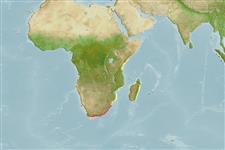>
Eupercaria/misc (Various families in series Eupercaria) >
Sparidae (Porgies)
Etymology: Boopsoidea: Greek, bous = caw + Greek, ops = appearance (Ref. 45335).
More on author: Castelnau.
Environment: milieu / climate zone / Tiefenbereich / distribution range
Ökologie
seewasser riff-verbunden; tiefenbereich 5 - 30 m (Ref. 3198). Subtropical
Southeast Atlantic: known only from the Cape to Natal in South Africa.
Size / Gewicht / Alter
Geschlechtsreife: Lm ? range ? - ? cm
Max length : 40.0 cm TL Männchen/unbestimmt; (Ref. 3678)
Kurzbeschreibung
Bestimmungsschlüssel | Morphologie | Morphometrie
Rückenflossenstacheln (insgesamt) : 11; Rückenflossenweichstrahlen (insgesamt) : 10 - 11; Afterflossenstacheln: 3; Afterflossenweichstrahlen: 11. Body bronzy; young vividly colored (Ref. 3198).
Body shape (shape guide): fusiform / normal.
Occurs usually in the vicinity of scattered and flat reefs from 5 to 30 m depth. Found in shoals. Feeds on small crabs, worms, red bait and small pieces of seaweeds. Good food fish but spoils rapidly. A good bait for larger game fish.
Life cycle and mating behavior
Geschlechtsreife | Fortpflanzung | Ablaichen | Eier | Fecundity | Larven
Smith, J.L.B. and M.M. Smith, 1986. Sparidae. p. 580-594. In M.M. Smith and P.C. Heemstra (eds.) Smiths' sea fishes. Springer-Verlag, Berlin. (Ref. 3198)
IUCN Rote Liste Status (Ref. 130435: Version 2025-1)
Bedrohung für Menschen
Harmless
Nutzung durch Menschen
Fischereien: weniger kommerziell; Köder: occasionally
Tools
Zusatzinformationen
Download XML
Internet Quellen
Estimates based on models
Preferred temperature (Ref.
123201): 17.6 - 27.5, mean 25.4 °C (based on 228 cells).
Phylogenetic diversity index (Ref.
82804): PD
50 = 1.0000 [Uniqueness, from 0.5 = low to 2.0 = high].
Bayesian length-weight: a=0.01259 (0.00609 - 0.02604), b=3.03 (2.86 - 3.20), in cm total length, based on LWR estimates for this (Sub)family-body shape (Ref.
93245).
Trophic level (Ref.
69278): 3.3 ±0.50 se; based on food items.
Widerstandsfähigkeit (Ref.
120179): mittel, Verdopplung der Population dauert 1,4 - 4,4 Jahre. (Preliminary K or Fecundity.).
Fishing Vulnerability (Ref.
59153): Low to moderate vulnerability (30 of 100).
🛈
Nutrients (Ref.
124155): Calcium = 34.8 [13.5, 58.8] mg/100g; Iron = 0.596 [0.307, 1.130] mg/100g; Protein = 20.3 [19.2, 21.5] %; Omega3 = 0.208 [0.126, 0.359] g/100g; Selenium = 12.6 [6.0, 25.1] μg/100g; VitaminA = 50.5 [14.3, 164.9] μg/100g; Zinc = 0.847 [0.550, 1.279] mg/100g (wet weight);
